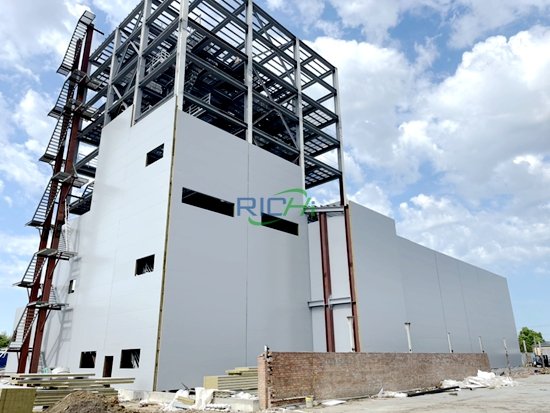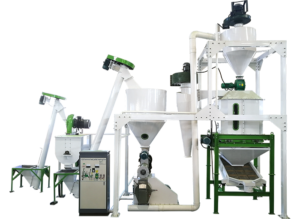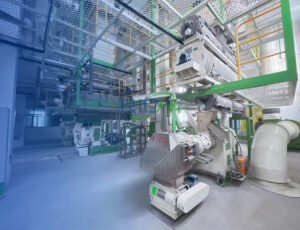
Introduction to Floating Fish Feed Production Lines
Floating fish feed is a crucial component in the aquaculture sector, playing a significant role in nourishing aquatic species efficiently. This type of feed is specially designed to float on the water surface, making it easier for fish to consume. The key advantage of floating fish feed is its ability to reduce feed waste and water pollution, thereby promoting a healthier aquatic environment and ensuring the optimal growth of fish.
A floating fish feed production line is an intricate setup designed to manufacture these specialized feeds with precision. The process begins with ingredient selection and preparation, followed by grinding, mixing, and extrusion. During extrusion, the feed material is subjected to high pressure and temperature, causing it to expand and form a puffed texture that enables it to float. Post-extrusion, the feed undergoes drying and cooling to stabilize its structure before being finally packaged for distribution.
The importance of selecting an appropriate floating fish feed production line cannot be overstated. The efficiency, reliability, and quality of the production line directly impact the nutritional value and physical characteristics of the feed, which in turn influence fish health and growth rates. Key parameters to consider when choosing a production line include throughput capacity, energy consumption, degree of automation, and versatility in handling various raw materials. Additionally, the ease of maintenance and availability of technical support are crucial factors that can affect the long-term productivity and operational costs of the production facility.
Understanding these parameters helps aquaculture operators make informed decisions that ultimately contribute to sustainable and profitable fish farming practices. By investing in a suitable floating fish feed production line, farmers can ensure that their aquatic stock receives high-quality nutrition, leading to better growth performance and overall health.
Key Parameters for Selecting a Floating Fish Feed Production Line
When selecting a floating fish feed production line, several critical parameters must be considered to ensure optimal performance and product quality. Firstly, production capacity is a paramount factor. It determines the volume of fish feed that can be produced within a specific timeframe. A production line with a higher capacity is essential for large-scale operations, while smaller setups may suffice for modest demands. https://www.richimanufacture.com/floating-fish-feed-extruder-machine/
Energy efficiency is another crucial consideration. A production line that operates efficiently can significantly reduce operational costs and environmental impact. Energy-efficient machinery typically utilizes advanced technology to minimize power consumption without compromising on performance, thereby enhancing overall profitability.
The level of automation within the floating fish feed production line greatly influences operational efficiency. Automation can encompass various processes, from ingredient mixing and extrusion to drying and packaging. A highly automated system minimizes human intervention, reduces labor costs, and ensures consistent product quality. Moreover, automation enhances precision in feed formulation, leading to better growth and health of the fish.
Versatility in feed sizes is also a vital parameter. Fish species require different pellet sizes, and the ability to produce various sizes on the same production line adds flexibility and adaptability to the production process. This versatility can cater to the needs of a diverse aquatic population, ensuring that nutritional requirements are met accurately.
Ease of maintenance is essential for sustaining long-term productivity. A floating fish feed production line that is easy to maintain will have lower downtime, fewer operational disruptions, and reduced maintenance costs. Features such as modular design, accessible components, and comprehensive support services contribute to easier maintenance.
By carefully considering production capacity, energy efficiency, automation level, versatility in feed sizes, and ease of maintenance, one can ensure they choose a floating fish feed production line that meets their specific requirements and upholds high standards of quality and efficiency in fish feed production.
Production Capacity and Energy Efficiency
When considering the acquisition of a floating fish feed production line, assessing production capacity and energy efficiency is crucial for aligning with operational goals and cost-effectiveness. Production capacity should be sufficient to meet the demand for fish feed, taking into account current and projected growth. It’s essential to define your daily, monthly, and annual production targets. Typically, fish feed production lines offer a range of production capacities from a few hundred kilograms to several tons per hour, ensuring scalability and adaptability to varying operation sizes.
It’s advisable to conduct a thorough analysis of your fish farming needs before deciding on a production line. Factors such as the type of fish, feeding habits, and the scale of the fish farm will significantly impact the desired production capacity. For instance, large commercial operations may require a high-capacity floating fish feed production line producing several tons of feed per hour, while small-scale farms might suffice with lower capacities.
In addition to production capacity, energy efficiency plays a pivotal role in minimizing operational costs and environmental impact. Efficient machinery can substantially reduce energy consumption, resulting in long-term savings. When evaluating a floating fish feed production line, scrutinize the specifications for energy consumption rates. High-efficiency motors, advanced control systems, and innovative design features can all contribute to improved energy efficiency.
Look for production lines that emphasize low energy consumption per unit of feed produced. Some manufacturers provide specifications on kWh (kilowatt-hour) consumption per ton of feed to help gauge energy efficiency. For example, a system that utilizes less than 50 kWh per ton of feed is generally considered energy-efficient. Additionally, features like automated control systems that optimize process parameters can further enhance both production capacity and energy efficiency.
Automation and Versatility in Feed Sizes
Automation within a floating fish feed production line represents a significant advancement in the aquaculture industry, bringing multifaceted benefits to producers. By integrating automated systems, companies can achieve considerable reductions in labor costs. These systems minimize the need for manual intervention, leading to lower operational expenditures and a more efficient allocation of human resources. Beyond cost savings, automation enhances precision in the production process, ensuring consistency in feed quality and reducing the likelihood of human error.
The capability to produce feed in various sizes is crucial for addressing the nutritional needs of different fish species as well as their respective growth stages. A floating fish feed production line equipped with advanced control systems can easily switch between different pellet sizes, catering to the specific dietary requirements of juvenile, adult, and mature fish. This versatility ensures that the feed provided optimally supports the health, growth, and overall well-being of the fish population.
Modern control systems embedded within automated fish feed production lines enable real-time monitoring and adjustments. This not only improves the production efficiency but also allows for customization of feed formulations based on specific nutritional profiles. For instance, altering parameters such as protein content, fat levels, and micronutrient additions can be managed seamlessly, responding to the dynamic demands of aquaculture environments.
Advanced automation systems bring together various technological elements, such as programmable logic controllers (PLCs), human-machine interfaces (HMIs), and Internet of Things (IoT) sensors, to streamline the operational workflow. These elements work in unison to optimize feed production, enhancing both the quality and consistency of the final product. Furthermore, the integration of data analytics aids in predictive maintenance, reducing downtime and prolonging the lifespan of equipment within the production line.
In conclusion, the adoption of automation and versatile feed size production capabilities in a floating fish feed production line is indispensable for modern aquaculture operations. These advancements lead to cost efficiencies, improved feed quality, and the ability to meet the diverse dietary needs of various fish species, ultimately contributing to more sustainable and productive aquaculture practices.
Ease of Maintenance and Durability
When selecting a floating fish feed production line, the consideration of maintenance and durability is of paramount importance. Maintenance consists of regular checks, part replacements, and unforeseen repairs, all of which can incur significant costs and downtime. Consequently, machinery that demands frequent or extensive maintenance can disrupt production schedules and reduce overall efficiency.
Durability plays a crucial role in minimizing these disruptions. High-quality, durable equipment requires less frequent repairs and is often more resilient under demanding operational conditions. Opting for a floating fish feed production line built with robust materials and advanced engineering can mitigate potential downtime, thereby maintaining a continuous production flow and optimizing operational output.
To evaluate the maintenance friendliness and durability of the equipment, manufacturers typically provide detailed maintenance outlines and durability ratings. Look out for features such as modular designs, which simplify the replacement of parts, and user-friendly interfaces that offer clear maintenance instructions. Furthermore, compliance with industry standards and certification can be key indicators of a machine’s reliability and durability.
Assessing the past user experiences and reviews can also offer invaluable insights. Engaging with existing customers who have experience with the floating fish feed production line in question can reveal the true ease of maintenance and durability over time. Questions about availability of spare parts and after-sales support are pivotal, as these factors significantly contribute to the overall maintenance experience.
Investing time in researching and selecting equipment that excels in both maintenance ease and durability ensures a smoother operational journey. By focusing on these parameters, the overall cost-efficiency of the production line enhances as reduced downtime directly correlates with increased productivity and profitability.
Manufacturer Recommendations: Top Three Choices
Choosing the right manufacturer for a floating fish feed production line can significantly impact both the quality of the feed and the efficiency of the production process. Our top three recommendations for manufacturers in this domain are based on their credibility, technological advancements, and robust customer support.
First on the list is ABC Machinery. Renowned for its cutting-edge technology and consistent innovation, ABC Machinery provides a floating fish feed production line that prioritizes efficiency and quality. The company’s advanced manufacturing techniques ensure high performance, durability, and energy efficiency. Moreover, their customer service is exemplary, providing comprehensive support ranging from installation to maintenance. Their commitment to R&D ensures they stay ahead of industry trends, making them a reliable choice for any aquaculture business.
Second, we recommend XYZ Industries. This manufacturer has gained a strong reputation for producing state-of-the-art equipment tailored to meet diverse production needs. Their floating fish feed machines are known for their precision and adaptability, accommodating various feed formulations with ease. XYZ Industries’ technological advancements are complemented by a dedicated customer support team that offers extensive training and troubleshooting services. Their systems are designed to be user-friendly, making them an excellent option for both large and small-scale feed producers.
Ranked third but no less significant is Richi Machinery. This company will be discussed in more detail later in the blog post, but it’s worth mentioning that Richi Machinery is recognized for its high-quality machinery and robust customer support. Their floating fish feed production line integrates modern technology with practical design, ensuring efficiency and high output. Richi Machinery also emphasizes sustainability and energy conservation, which is increasingly important in today’s environmentally conscious market.
These manufacturers represent the pinnacle of innovation and service in the floating fish feed production industry, making them top choices for anyone looking to optimize their aquaculture operations.
Richi Machinery: Leading Professional in China
Richi Machinery stands as a premier figure in the realm of floating fish feed production lines. Renowned as the most professional pellet machine manufacturer in China, Richi’s reputation is further bolstered by its status as the largest such enterprise in Henan Province. The company has cultivated a deep well of expertise and industry knowledge, enabling it to deliver high-quality machinery tailored to the diverse needs of its clients.
Richi Machinery’s market position is a testament to its unwavering commitment to excellence and innovation. By continually upgrading its technology and maintaining stringent quality control measures, the company has carved out a substantial market share both domestically and internationally. Each piece of equipment from Richi is designed for durability, efficiency, and ease of use, making it a preferred choice for those in the aquaculture industry.
One of the primary factors contributing to the company’s success is its comprehensive range of services that cater to various stages of the production process. Beyond manufacturing superior floating fish feed production lines, Richi offers all-encompassing turnkey solutions. These include technical consultation, project planning, design, manufacturing, installation, commissioning, and after-sales support. This holistic approach ensures that customers receive not only state-of-the-art machinery but also reliable support throughout the lifespan of their equipment.
Among Richi Machinery’s flagship products are the SZLH Series Fish Feed Pellet Mills, which are celebrated for their robust construction and high efficiency. These machines offer unparalleled output and can handle a variety of raw materials, ensuring optimal feed conversion ratios. Another notable offering is the aquatic feed production line, designed to produce high-quality floating and sinking fish feeds, meticulously tailored to meet precise nutritional requirements.
Richi Machinery’s unique selling points include its innovative technology, dedicated customer service, and extensive industry experience. By placing a strong emphasis on research and development, Richi ensures that its equipment remains at the cutting edge, providing clients with the tools necessary to thrive in a competitive market. The company’s dedication to quality and customer satisfaction makes it a standout in the field of floating fish feed production lines.
Conclusion and Final Recommendations
As we have explored throughout this blog post, choosing a floating fish feed production line involves an in-depth analysis of various key parameters. These parameters include production capacity, energy efficiency, automation level, and the quality of the final feed product. Equally important are considerations of cost-effectiveness and ease of maintenance, factors that often influence long-term operational sustainability.
When evaluating manufacturers, it is essential to recognize the significant contributions leading companies bring to the industry. Among the top manufacturers, Richi Machinery stands out prominently, offering innovative solutions and robust machinery designed to meet the diverse needs of aquaculture businesses. Their commitment to quality, technological advancement, and customer support make them a reliable choice for many.
While there are several reputable manufacturers to consider, selecting the right floating fish feed production line should ultimately align with your specific operational requirements and strategic goals. Tailoring your purchase to meet the unique demands of your production scale, feed formulation, and budget constraints can lead to optimal results and sustained business growth.
In conclusion, making an informed decision involves a thorough understanding of both the technical specifications and the market offerings. We encourage readers to leverage the insights provided in this blog post to guide their selection process. By doing so, you can ensure that your investment in a floating fish feed production line will not only enhance your production efficiency but also contribute to the overall success of your aquaculture endeavors.






